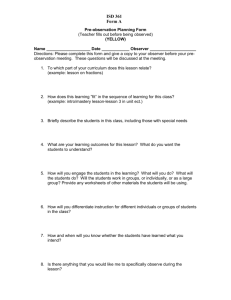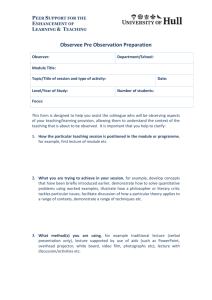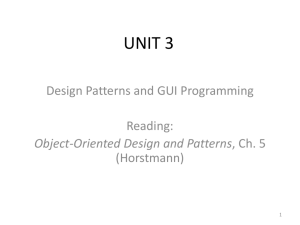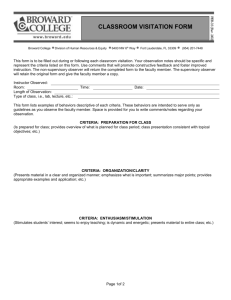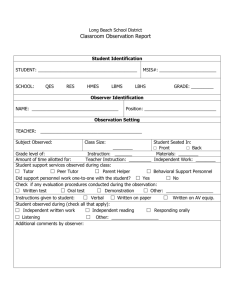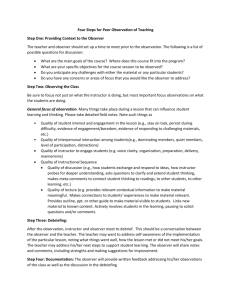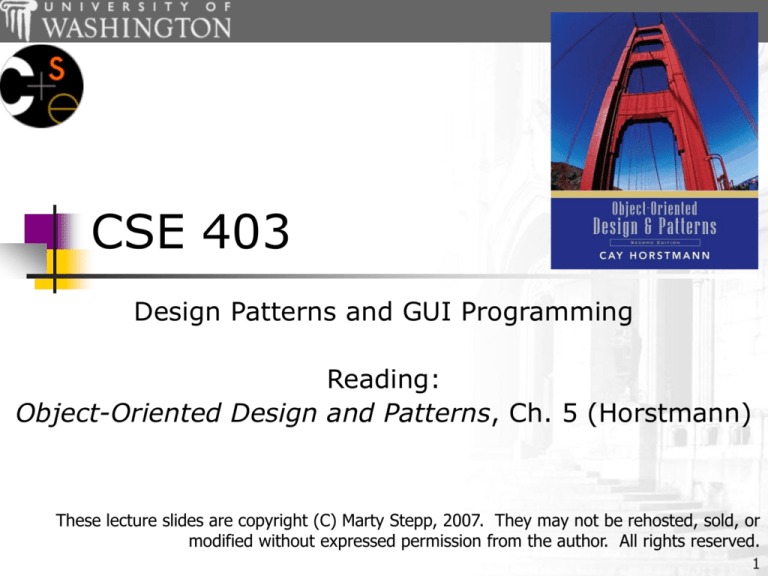
CSE 403
Design Patterns and GUI Programming
Reading:
Object-Oriented Design and Patterns, Ch. 5 (Horstmann)
These lecture slides are copyright (C) Marty Stepp, 2007. They may not be rehosted, sold, or
modified without expressed permission from the author. All rights reserved.
1
Big questions
What is a design pattern?
What is the advantage of knowing/using
design patterns?
Which patterns are named in the reading?
What are the key ideas of those patterns?
2
Design challenges
Designing software for reuse is hard. One must find:
a good problem decomposition, and the right software
a design with flexibility, modularity and elegance
designs often emerge from trial and error
successful designs do exist
two designs they are almost never identical
they exhibit some recurring characteristics
Can designs be described, codified or standardized?
this would short circuit the trial and error phase
produce "better" software faster
3
Design patterns
design pattern:
a solution to a common software problem in a context
describes a recurring software structure
is abstract from programming language
identifies classes and their roles in the solution to a problem
patterns are not code or designs; must be instantiated/applied
example: Iterator pattern
The Iterator pattern defines an interface that declares methods
for sequentially accessing the objects in a collection.
4
History of patterns
the concept of a "pattern" was first expressed
in Christopher Alexander's work A Pattern
Language in 1977 (2543 patterns)
in 1990 a group called the Gang of Four or "GoF"
(Gamma, Helm, Johnson, Vlissides) compile a
catalog of design patterns
1995 book Design Patterns:
Elements of Reusable Object-Oriented
Software is a classic of the field
5
Benefits of using patterns
patterns are a common design vocabulary
patterns capture design expertise and allow that
expertise to be communicated
allows engineers to abstract a problem and talk about that
abstraction in isolation from its implementation
embodies a culture; domain-specific patterns increase design
speed
promotes design reuse and avoid mistakes
improve documentation (less is needed) and
understandability (patterns are described well once)
6
Gang of Four (GoF) patterns
Creational Patterns
(abstracting the object-instantiation process)
Abstract Factory
Prototype
Singleton
Structural Patterns
(how objects/classes can be combined to form larger structures)
Factory Method
Builder
Adapter
Decorator
Proxy
Bridge
Facade
Composite
Flyweight
Behavioral Patterns
(communication between objects)
Command
Mediator
Strategy
Template Method
Interpreter
Observer
Chain of Responsibility
Iterator
State
Visitor
7
Pattern: Iterator
objects that traverse collections
8
Iterator pattern
iterator: an object that provides a standard way to
examine all elements of any collection
uniform interface for traversing many different data structures
supports concurrent iteration and element removal
for (Iterator<Account> itr = list.iterator(); itr.hasNext(); ) {
Account a = itr.next();
set.iterator()
System.out.println(a);
map.keySet().iterator()
}
map.values().iterator()
9
Pattern: Observer
objects whose state can be watched
10
Recall: model and view
model: classes in your system that are related to the
internal representation of the state of the system
often part of the model is connected to file(s) or database(s)
examples (card game): Card, Deck, Player
examples (bank system): Account, User, UserList
view: classes in your system that display the state of
the model to the user
generally, this is your GUI (could also be a text UI)
should not contain crucial application data
Different views can represent the same data in different ways
Example: Bar chart vs. pie chart
examples: PokerPanel, BankApplet
11
Model-view-controller
model-view-controller (MVC): common design
paradigm for graphical systems
controller: classes that connect model and view
defines how user interface reacts to user input (events)
receives messages from view (where events come from)
sends messages to model (tells what data to display)
sometimes part of view (see left)
Model
data for
rendering
View
Component
events
updates
Model
View
Controller
Controller
12
Observer pattern
observer: an object that "watches" the state of
another object and takes action when the state
changes in some way
examples in Java: event listeners; java.util.Observer
observable object: an object that allows observers to
examine it (often the observable object notifies the
observers when it changes)
permits customizable, extensible event-based behavior for data
modeling and graphics
13
Benefits of observer
abstract coupling between subject and observer; each
can be extended and reused individually
dynamic relationship between subject and observer;
can be established at run time (can "hot-swap" views,
etc) gives a lot more programming flexibility
broadcast communication: notification is broadcast
automatically to all interested objects that subscribed
to it
Observer can be used to implement model-view
separation in Java more easily
14
Observer sequence diagram
15
Observer interface
package java.util;
public interface Observer {
public void update(Observable o, Object arg);
}
Idea: The update method will be called when the
observable model changes, so put the appropriate code
to handle the change inside update
16
Observable class
public void addObserver(Observer o)
public void deleteObserver(Observer o)
Adds/removes o to/from the list of objects that will be notified (via their
update method) when notifyObservers is called.
public void notifyObservers()
public void notifyObservers(Object arg)
Inform all observers listening to this Observable object of an event that
has occurred. An optional object argument may be passed to provide
more information about the event.
public void setChanged()
Flags the observable object as having changed since the last event; must
be called each time before calling notifyObservers.
17
Common usage of Observer
1. write a model class that extends Observable
have the model notify its observers when anything significant
happens
2. make all views of that model (e.g. GUI panels that
draw the model on screen) into observers
have the panels take action when the model notifies them of
events (e.g. repaint, play sound, show option dialog, etc.)
18
Using multiple views
make an Observable model
write a View interface or abstract class
extend/implement View for all actual views
make View an observer
give each its own unique inner components and code to draw
the model's state in its own way
provide mechanism in GUI to set view (perhaps
through menus)
to set view, attach it to observe the model
19
Example: changing views
// in the frame's action listener:
// hide old view; show new one
model.deleteObserver(view1);
model.addObserver(view2);
view1.setVisible(false);
view2.setVisible(true);
20
Pattern: Strategy
objects that hold alternate algorithms to solve a
problem
21
Strategy pattern
strategy: an algorithm separated from the object that
uses it, and encapsulated as its own object
each strategy implements one behavior, one implementation of
how to solve the same problem
separates algorithm for behavior from object that wants to act
allows changing an object's behavior dynamically without
extending / changing the object itself
examples:
file saving/compression
layout managers on GUI containers
AI algorithms for computer game players
22
Strategy example: Card player
// Strategy hierarchy parent
// (an interface or abstract class)
public interface Strategy {
public Card getMove();
}
// setting a strategy
player1.setStrategy(new SmartStrategy());
// using a strategy
Card p1move = player1.move();
// uses strategy
23
Containers with layout
The idea: Place many components into a special component called
a container, then add the container to the window frame
24
Container
container: an object that holds components; it also
governs their positions, sizes, and resize behavior
public void add(Component comp)
public void add(Component comp, Object info)
Adds a component to the container, possibly giving
extra information about where to place it.
public void remove(Component comp)
Removes the given component from the container.
public void setLayout(LayoutManager mgr)
Uses the given layout manager to position the
components in the container.
public void validate()
You should call this if you change the contents of a
container that is already on the screen, to make it redo its layout.
25
Pattern: Composite
objects that can serve as containers, and can hold
other objects like themselves
26
Composite pattern
composite: an object that is either an individual item
or a collection of many items
composite objects can be composed of individual items or of
other composites
recursive definition: objects that can hold themselves
often leads to a tree structure of leaves and nodes:
<node>
::= <leafnode> | <compositenode>
<compositenode> ::= <node>*
examples in Java:
collections (a List of Lists)
GUI layout (panels containing panels containing buttons, etc.)
27
Composite example: panels
Container north = new JPanel(new FlowLayout());
north.add(new JButton("Button 1"));
north.add(new JButton("Button 2"));
Container south = new JPanel(new BorderLayout());
south.add(new JLabel("Southwest"), BorderLayout.WEST);
south.add(new JLabel("Southeast"), BorderLayout.EAST);
// overall panel contains the smaller panels (composite)
JPanel overall = new JPanel(new BorderLayout());
overall.add(north, BorderLayout.NORTH);
overall.add(new JButton("Center Button"), BorderLayout.CENTER);
overall.add(south, BorderLayout.SOUTH);
frame.add(overall);
28
Pattern: Decorator
objects that wrap around other objects to add
useful features
29
Decorator pattern
decorator: an object that modifies behavior of, or
adds features to, another object
decorator must maintain the common interface of the object it
wraps up
used so that we can add features to an existing simple object
without needing to disrupt the interface that client code expects
when using the simple object
the object being "decorated" usually does not explicitly know
about the decorator
examples in Java:
multilayered input streams adding useful I/O methods
adding scroll bars to GUI controls
30
Decorator example: I/O
normal InputStream class has only public int
read() method to read one letter at a time
decorators such as BufferedReader or Scanner add
additional functionality to read the stream more easily
// InputStreamReader/BufferedReader decorate InputStream
InputStream in = new FileInputStream("hardcode.txt");
InputStreamReader isr = new InputStreamReader(in);
BufferedReader br = new BufferedReader(isr);
// because of decorator streams, I can read an
// entire line from the file in one call
// (InputStream only provides public int read() )
String wholeLine = br.readLine();
31
Decorator example: GUI
normal GUI components don't have scroll bars
JScrollPane is a container with scroll bars to which you
can add any component to make it scrollable
// JScrollPane decorates GUI components
JTextArea area = new JTextArea(20, 30);
JScrollPane scrollPane = new JScrollPane(area);
contentPane.add(scrollPane);
JComponents also have a setBorder method to add a
"decorative" border. Is this another example of the Decorator
pattern? Why or why not?
32
References
The Java Tutorial: Visual Index to the Swing Components.
http://java.sun.com/docs/books/tutorial/
uiswing/components/components.html
The Java Tutorial: Laying Out Components Within a Container.
http://java.sun.com/docs/books/tutorial/uiswing/
layout/index.html
Java Class Library Reference: Observer, Observable.
http://java.sun.com/j2se/1.5.0/docs/api/java/util/Observer.html
http://java.sun.com/j2se/1.5.0/docs/api/java/util/Observable.html
Cunningham & Cunningham OO Consultancy, Inc.
http://c2.com/cgi/wiki?IteratorPattern
http://c2.com/cgi/wiki?DecoratorPattern
http://c2.com/cgi/wiki?CompositePattern
Design Patterns Java Companion
http://www.patterndepot.com/put/8/JavaPatterns.htm
33

